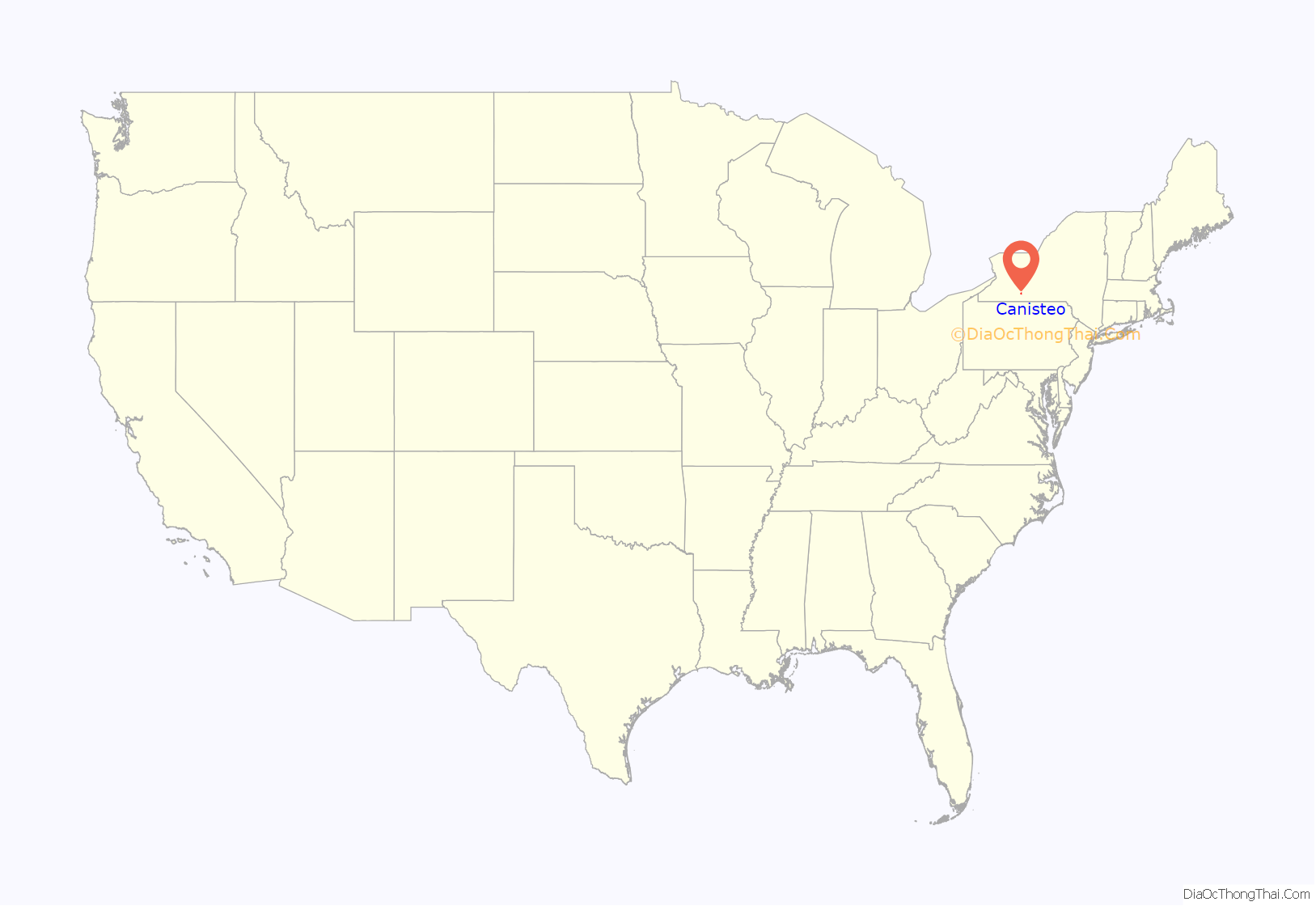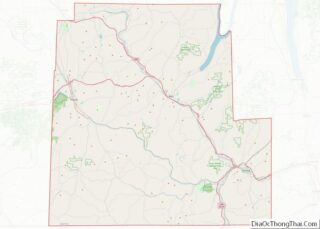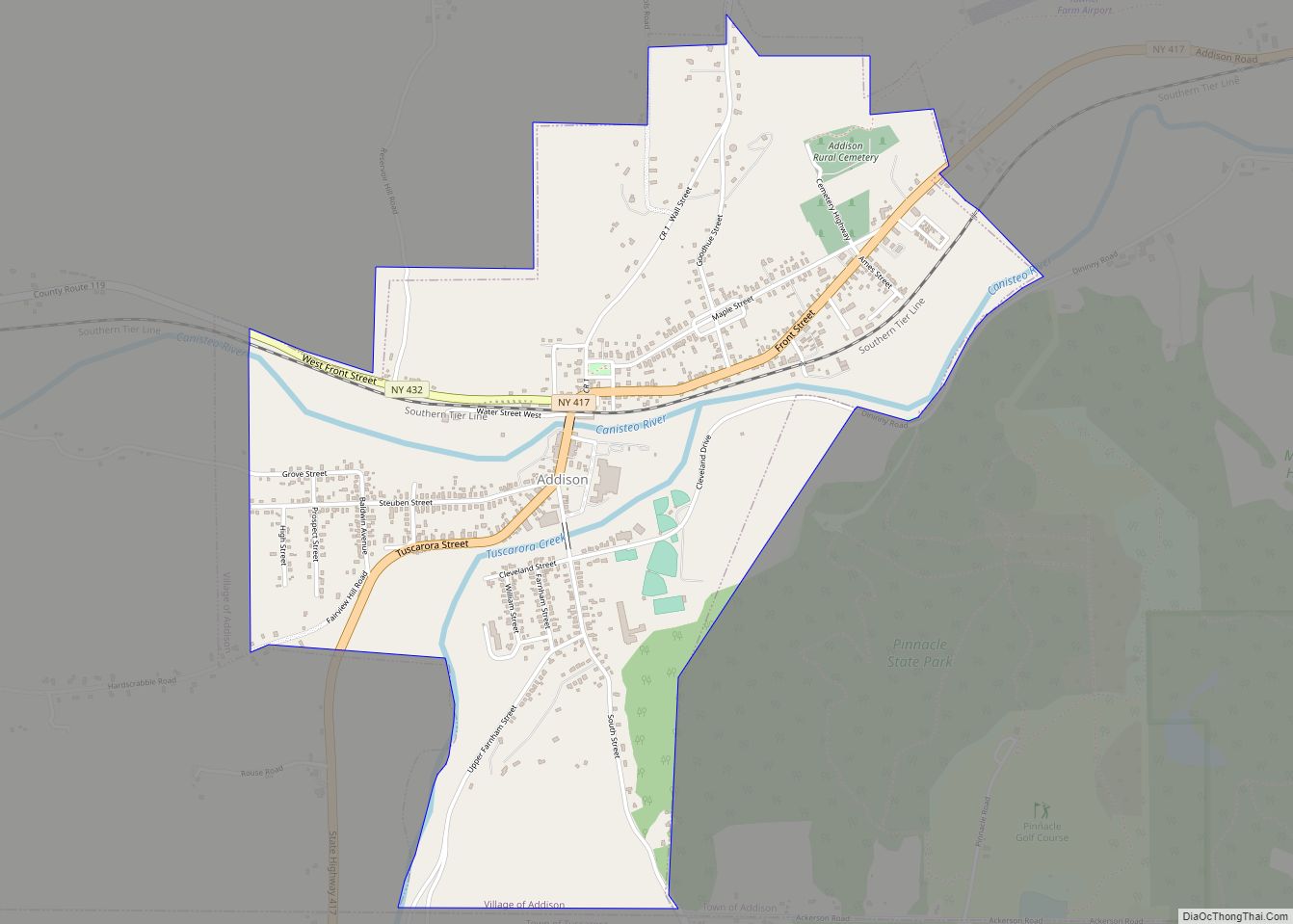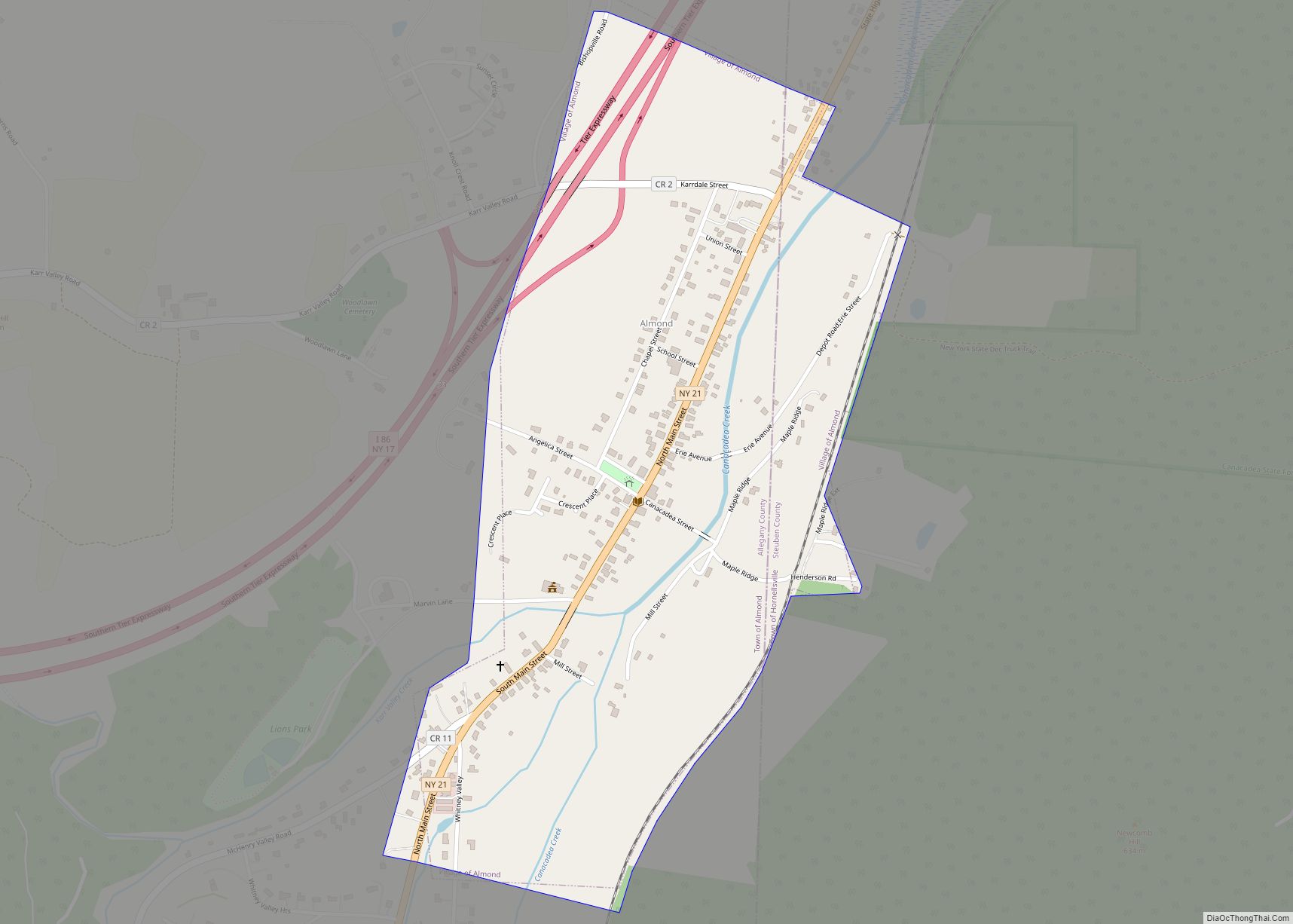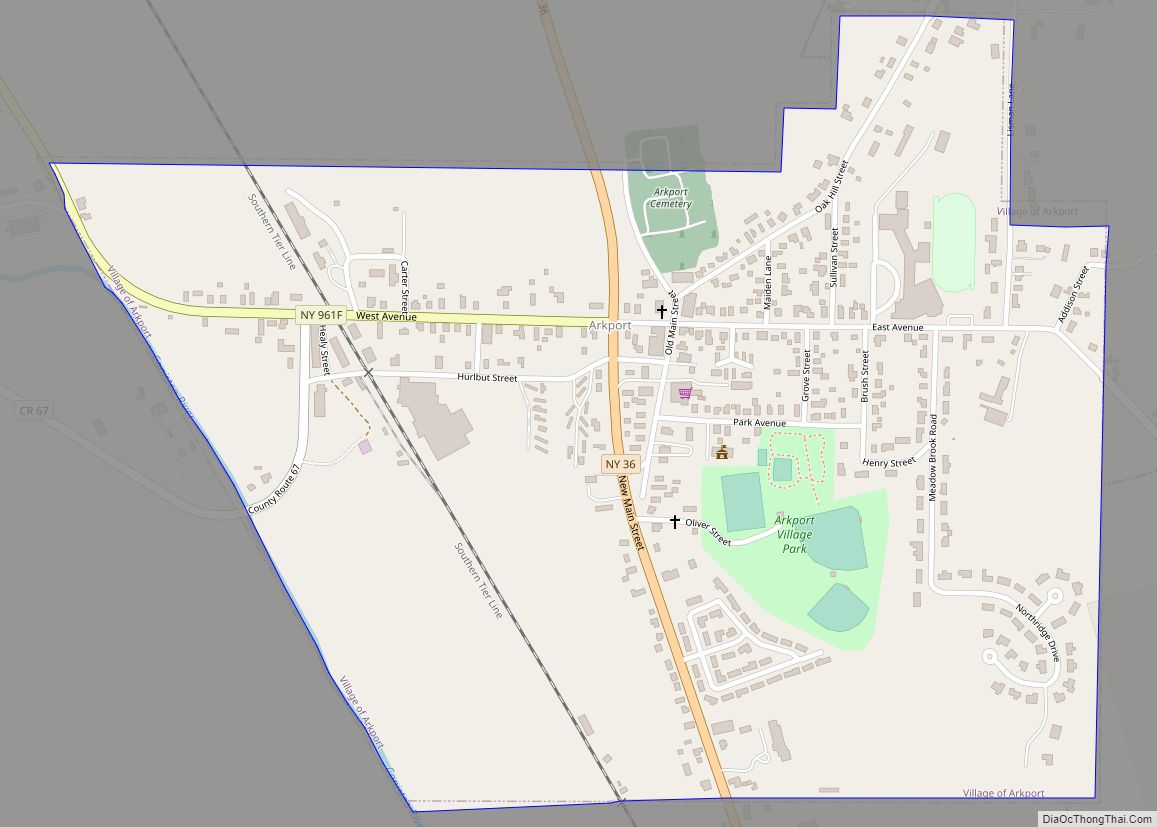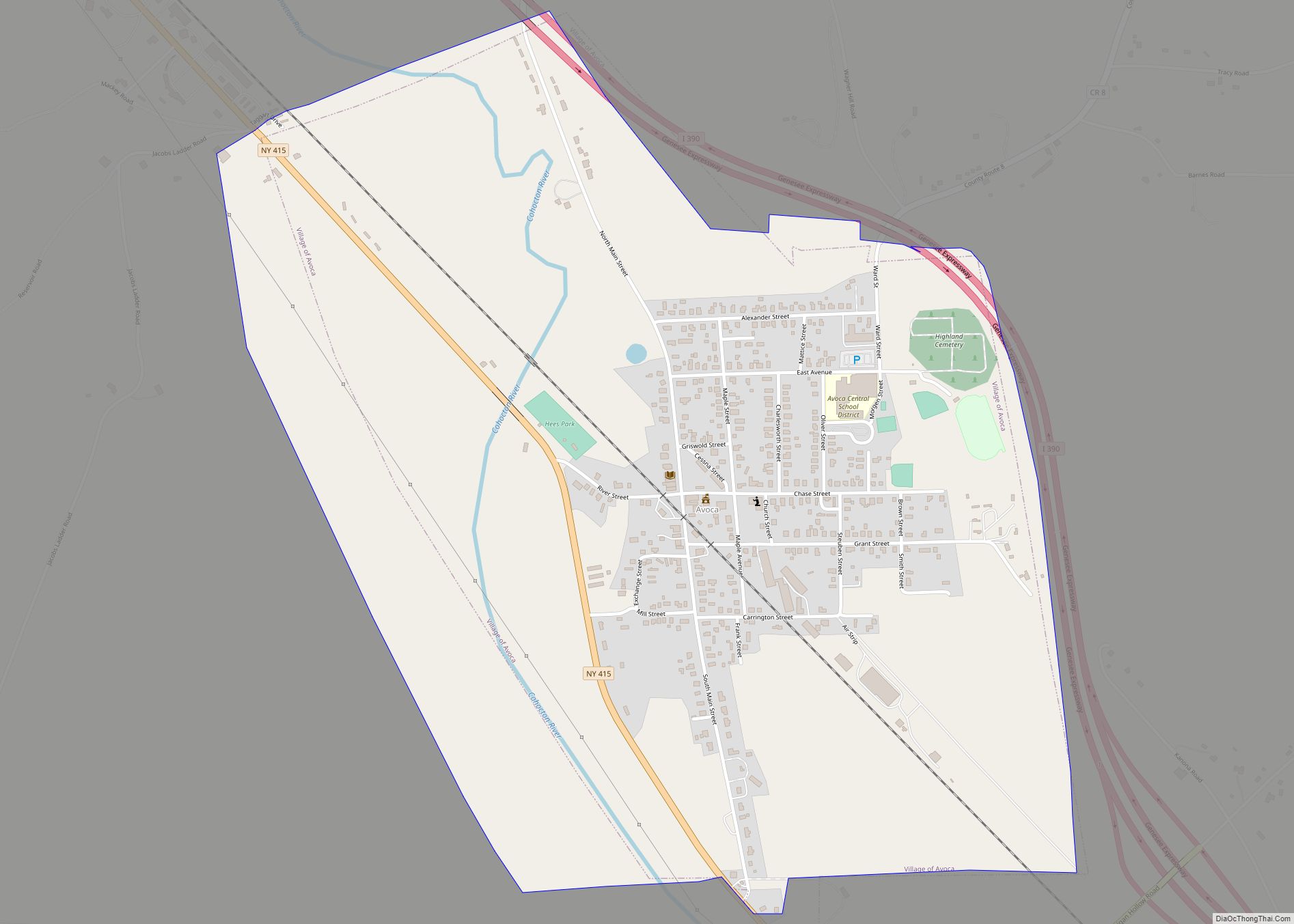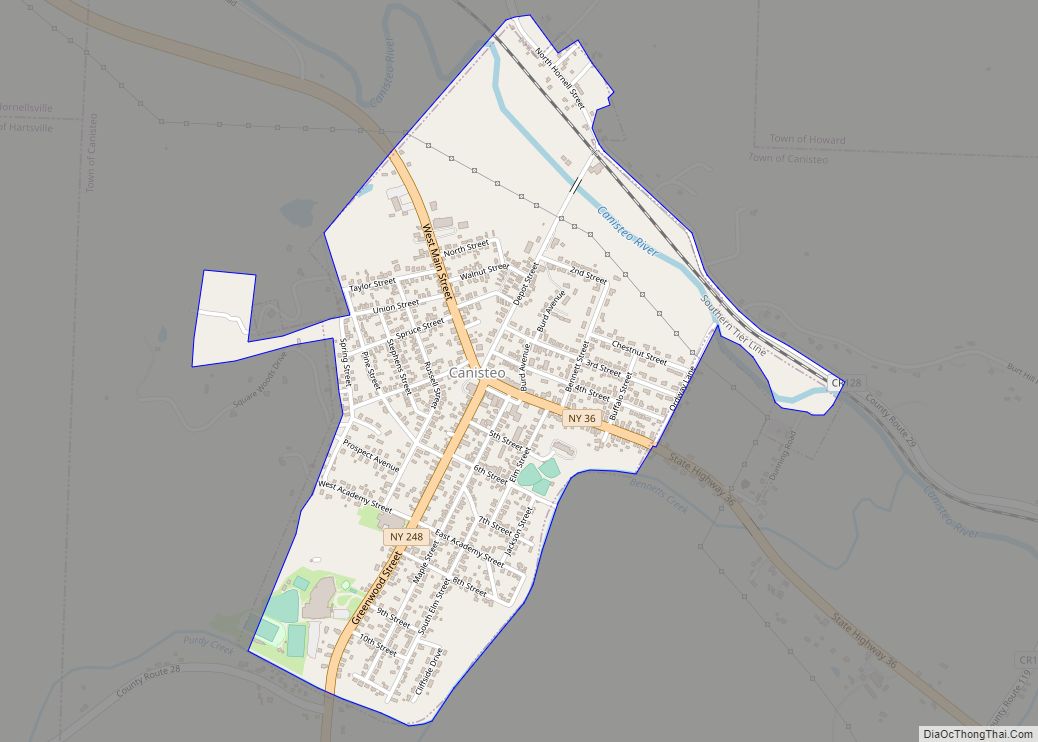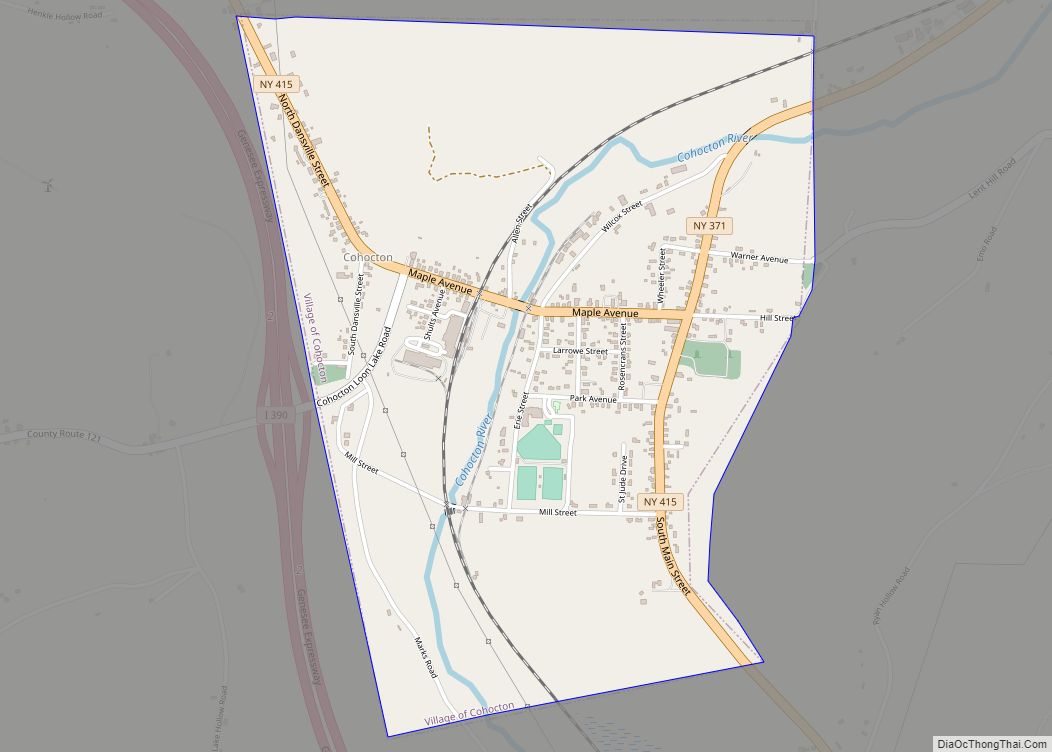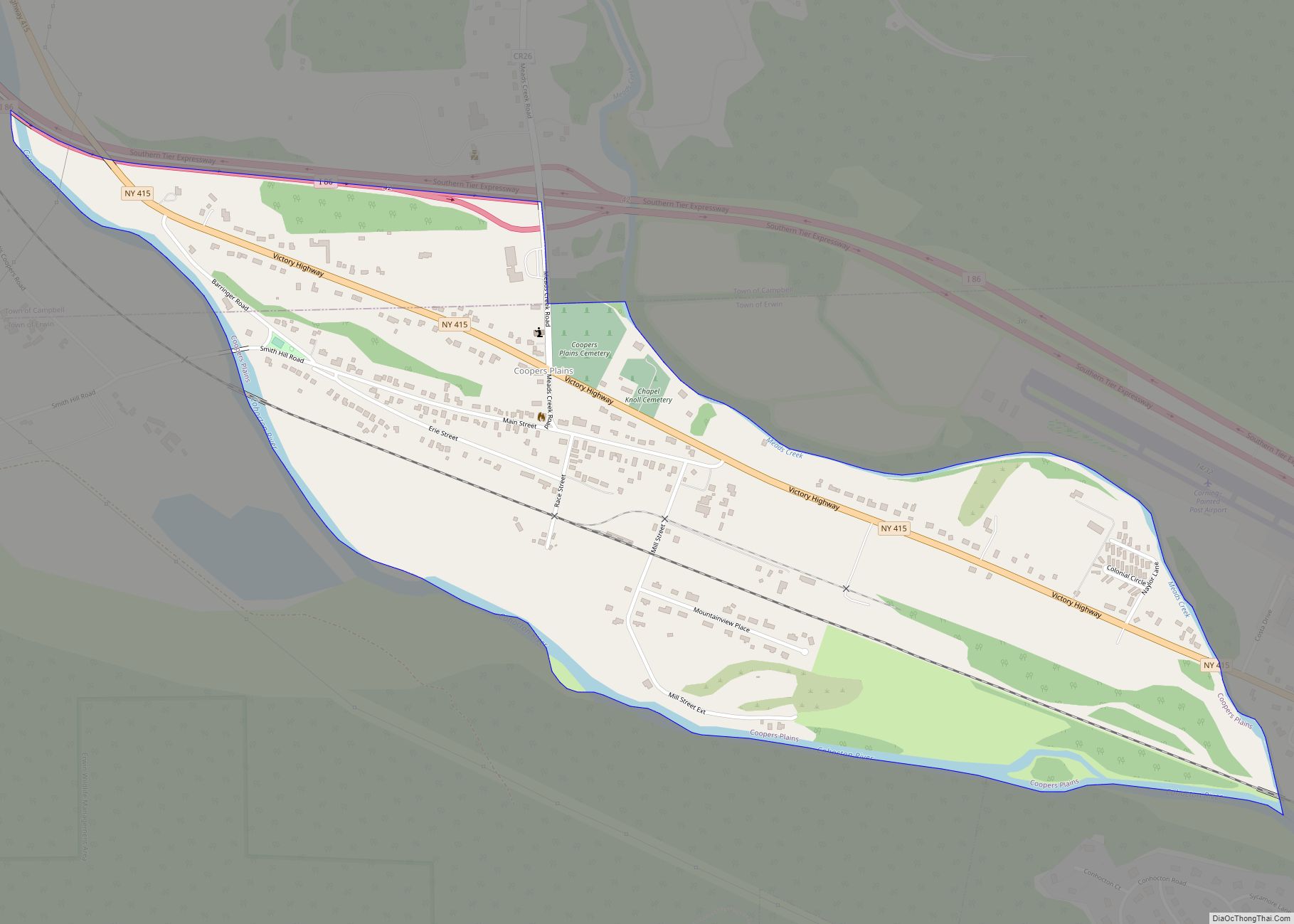Canisteo (/ˌkænɪsˈtiːoʊ/) is a village in Steuben County, New York, United States. The population was 2,270 at the 2010 census.
The Village of Canisteo is in the northwest corner of the Town of Canisteo and is southeast of Hornell.
| Name: | Canisteo village |
|---|---|
| LSAD Code: | 47 |
| LSAD Description: | village (suffix) |
| State: | New York |
| County: | Steuben County |
| Elevation: | 1,135 ft (346 m) |
| Total Area: | 0.93 sq mi (2.42 km²) |
| Land Area: | 0.93 sq mi (2.42 km²) |
| Water Area: | 0.00 sq mi (0.00 km²) |
| Total Population: | 2,176 |
| Population Density: | 2,329.76/sq mi (899.84/km²) |
| ZIP code: | 14823 |
| Area code: | 607 |
| FIPS code: | 3612254 |
| GNISfeature ID: | 0945774 |
Online Interactive Map
Click on ![]() to view map in "full screen" mode.
to view map in "full screen" mode.
Canisteo location map. Where is Canisteo village?
History
Native Americans
Canisteo existed as a community prior to European settlement, but there are different versions of who the inhabitants were and what the settlement consisted of. In the seventeenth and eighteenth centuries Canisteo was in a remote area, between territories of the Seneca and Delaware Indians, “a sort of No Man’s Land”. There are references to a “Kanestio castle”, but differing accounts of what it was, or even what was meant by “castle”. One modern writer calls it “mysterious”, noting that “facts about [it] are few and difficult to come by.” A well-known version is that of Steuben County historian Harlo Hakes, published in 1896:
“The Delaware Indian town which had been dignified by some writers with the name of ‘Kanestio Castle’…is said to have contained about sixty hewed log houses, with stone chimneys in each, and to have been the home or seat of operations of a noted ‘Delaware King,’ known as At-weet-sera.” The destruction of the Indian village took place in 1765.
European settlers
According to William Stuart, “The history of Kanestio Castle constitutes the genesis of Steuben County”. It is the first place in what became Steuben County to be mentioned in writing. Just what the word “castle” means is not clear, and precisely where it was is not known either. There is no mention of any castle in the European sense of a large stone building. It may mean nothing more than that it was a permanent, as opposed to transitory, settlement. The earliest description, from a French colonial historian of about 1690, is that Kanestio consisted of “‘several score of houses built of timber, each having four stone chimneys, adjoining a natural meadow of several hundred arpents.’ Kanestio Castle!”. Another modern writer reports the same information as “a luxurious castle of logs, 26 feet (7.9 m) long by 24 feet (7.3 m) wide”, now with four fireplaces. The stone chimneys are unquestionably a European artifact. The same French historian, describing an expedition south from what is today Kingston, Ontario, says that Kanestio was a community of European outlaws: “A more worthless lot of renegades and villains, who had no hope of heaven or fear of hell, we never saw.” They were from diverse backgrounds, and speaking different languages (“polyglot”).
There is no further written reference to Kanestio for 72 years. In 1762 two Dutch traders, British subjects, were killed by “a brace of outlaws from the Castle,” described in another source as “the Indians from Kanestio”. Kanestio was then described as “the largest Delaware [Indian] town”, but also according to the same source, it was “a village of lawless stragglers”. The English governor Sir William Johnson, in response, sent a party of “Indians” and British troops in 1764, under the command of Andrew Montour. At Kanestio they “burned 60 good houses, a vast amount of corn, agricultural implements and saddles.” The settlement at Kanestio Castle was eliminated.
An Indian village of Kanestio appears in the 1928 novel The Plains of Abraham, by James Curwood.
Settlers began arriving at what would become a new community around 1789. It was one of the first settlements in what is today Steuben County. Immigration and commerce were via what is today Pennsylvania, where the Canisteo River led to; there were no direct connections with Albany or New York City. The largest growth came after the Erie Railroad, which did provide a link to New York, arrived in 1851, when many factories opened. The village was incorporated in 1873.
The village of Canisteo was originally (prior to its incorporation) called Bennettsville. The original Canisteo, today a hamlet called Canisteo Center or Carson, was southeast of the present village, along the river. When the Erie Railroad was built in 1850, there was not room for a depot between the tracks and the Canisteo River, so the depot was built upriver, at the south of the tracks, on the west side of Depot Street. A “fairly large settlement”, which disappeared in the twentieth century, grew up near the depot, on the north side of the river and tracks. Depot Street (renamed Railroad Street while the trolley ran down it) was built to connect the depot to the Canisteo House hotel. A large community, with businesses and shops, and other hotels, sprang up.
The railroad era
Railroad Street – Greenwood Street was in the nineteenth and early twentieth centuries the principal street of Canisteo. On an 1873 map, Main Street (neither East nor West) stretched from Railroad/Greenwood Street to what was later called Ordway Lane, where the street ended. In the other direction, one traveled north from Railroad/Greenwood Street along Hornellsville Street.
Until 1851, when the Erie Railroad began operations, traffic was via the Canisteo River. The Erie ended that traffic, although an undated picture, which must be post-Erie since it includes a bicycle, shows a horse-drawn “stage” making two trips a day to Hornell. Aside from that the Erie was the sole route until 1892, when the Hornellsville & Canisteo Railway (a trolley line) linked Canisteo with Hornell; the trolley passed by the Erie station, linking it via Depot Street with the center of Canisteo, over half a mile away. By road, the main connection was the Canisteo River Road, today (2019) Steuben County route 29 between Canisteo and Hornell, route 119 between Canisteo and Cameron. The new hard-surface road between Hornell and Canisteo that later became New York Route 36 was built in 1912. (That road was destroyed by Hurricane Agnes in 1972; the current four-lane route is higher up.) With the growth of automobiles this replaced the railroad, Depot St. declined in importance, and Hornellsville Street was turned into West Main Street and the former Main St. into East Main St. All Erie service to Canisteo ended in the 1940s; there were still freight trains, but none stopped in Canisteo.
The first manufacturer in the village was L. Allison’s “large boot and shoe factory”, founded in 1868.
A map with business notices from 1873 reveals that Canisteo had three physicians, one dentist, four attorneys, one tailor, one stable, a cooper, a foundry, three groceries and a meat market, and small manufacturers of shoes and boots, bee hives, a flour mill, a cheese factory, a rake factory, and some others. On Railroad Street (later Depot Street) was the Canisteo Steam Power Company, which manufactured steam engines and employed 10–12 workers. Perhaps it is because of it that Canisteo had a “Times Steam Print”, the “Times” presumably a reference to the Canisteo Times, whose office was on Railroad Street.
In 1878 the manufactures of Canisteo amounted to a million dollars. At various times there were factories making buttons, rulers, dresses, signs, Superior registers, baskets, and car springs.
A picture from 1880 reveals that on the west side of Greenwood St. there was a bookstore run by Allison B. Laine. A J. H. Stewart owned, at 23 Main St. (later East Main St.) a store selling pianos, organs, and sheet music.
An American LaFrance fire engine was purchased in 1881. The Canisteo Water Works was built in 1887; the bandstand in the park in 1888.
In 1888 Canisteo was described as prosperous. “While the factories over the country are reducing the hours of labor her industries are wide-awake, and have more than enough to keep them running full time.”
In the late 19th century Canisteo was a temperance community. This was seen as progressive.
In 1890 Canisteo had a professional baseball team.
In 1891 the Farmer’s Co-Operative Insurance Company was organized in Canisteo, and grew to be “one of the most successful fire insurance companies in the state”. The same clipping reveals that in 1925 there was a potato club in Canisteo, with a membership of 32 boys and the support of the Erie Railroad and “the state school of agriculture at Alfred”.
In 1892, 20 arc lights were installed for street illumination.
A business directory of 1893 reports that: Canisteo “has a bank, weekly newspaper, four churches, well-equipped fire department, three hotels, and a first-class academy. Very few villages of its size have the industries equal to this place. The principal ones are the manufacturing of doors, sash and blinds, boots and shoes, leather, fence wire, incandescent lamps, hubs and spokes, washing machines, etc.”
In 1898 Canisteo got gas from Hornell for heating, after an earlier experiment in generating it in Canisteo.
20th century
Canisteo got telephone service about 1902. It got dial service about 1950; the original building, on Fifth St., is still (2015) in use. Numbers were four digits, beginning with 2- or 4-, and the only pay phone in town, in the school, with 8-. However, it was an isolated island until the commercial center of Hornell got dial service in 1963. To call Hornell, one dialed 3- for a Hornell operator. This is probably a reason why Hornell’s exchange, 324, begins with a 3-. The only other dialable location was the hamlet of Cameron, whose exchange was accessed by dialing 5-, perhaps reflected in Cameron’s exchange (607) 695-.
Presidential candidate William Jennings Bryan spoke in Canisteo in 1924.
To create parking for downtown merchants, in the 1950s The Green, Canisteo’s central park, between East Main, Greenwood, South Main, and Maple Streets, was sacrificed. It had had an old-fashioned, huge drinking fountain; older photos show a small bandstand.
Canisteo Road Map
Canisteo city Satellite Map
Geography
Canisteo is located at 42°16′12″N 77°36′23″W / 42.27000°N 77.60639°W / 42.27000; -77.60639 (42.270178, -77.606616).
According to the United States Census Bureau, the village has a total area of 1.0 square miles (2.5 km), all land.
The village is located at the junction of New York State Route 36 and New York State Route 248. County Route 28 joins New York State Route 36 south of the village and County Route 119 passes the north side of Canisteo.
The Canisteo River, flowing southeasterly, passes the northern side of the village, where it is joined by Bennetts Creek.
See also
Map of New York State and its subdivision:- Albany
- Allegany
- Bronx
- Broome
- Cattaraugus
- Cayuga
- Chautauqua
- Chemung
- Chenango
- Clinton
- Columbia
- Cortland
- Delaware
- Dutchess
- Erie
- Essex
- Franklin
- Fulton
- Genesee
- Greene
- Hamilton
- Herkimer
- Jefferson
- Kings
- Lake Ontario
- Lewis
- Livingston
- Madison
- Monroe
- Montgomery
- Nassau
- New York
- Niagara
- Oneida
- Onondaga
- Ontario
- Orange
- Orleans
- Oswego
- Otsego
- Putnam
- Queens
- Rensselaer
- Richmond
- Rockland
- Saint Lawrence
- Saratoga
- Schenectady
- Schoharie
- Schuyler
- Seneca
- Steuben
- Suffolk
- Sullivan
- Tioga
- Tompkins
- Ulster
- Warren
- Washington
- Wayne
- Westchester
- Wyoming
- Yates
- Alabama
- Alaska
- Arizona
- Arkansas
- California
- Colorado
- Connecticut
- Delaware
- District of Columbia
- Florida
- Georgia
- Hawaii
- Idaho
- Illinois
- Indiana
- Iowa
- Kansas
- Kentucky
- Louisiana
- Maine
- Maryland
- Massachusetts
- Michigan
- Minnesota
- Mississippi
- Missouri
- Montana
- Nebraska
- Nevada
- New Hampshire
- New Jersey
- New Mexico
- New York
- North Carolina
- North Dakota
- Ohio
- Oklahoma
- Oregon
- Pennsylvania
- Rhode Island
- South Carolina
- South Dakota
- Tennessee
- Texas
- Utah
- Vermont
- Virginia
- Washington
- West Virginia
- Wisconsin
- Wyoming
